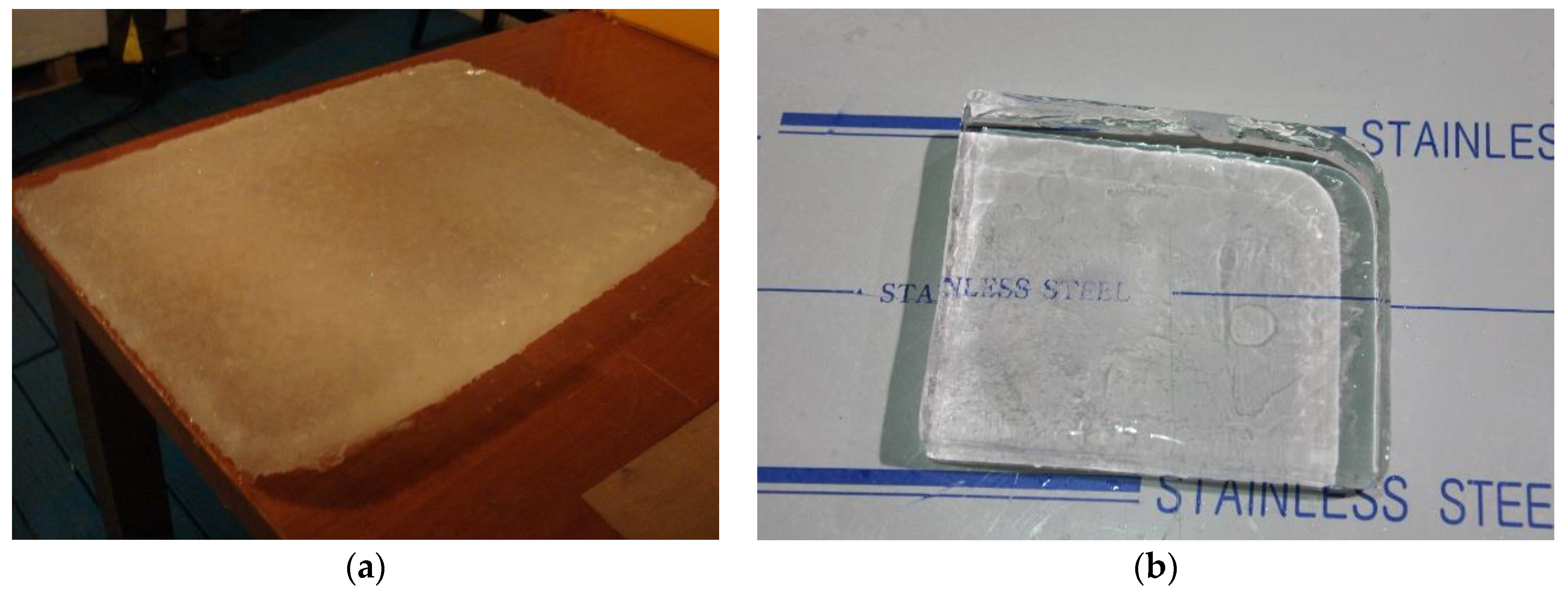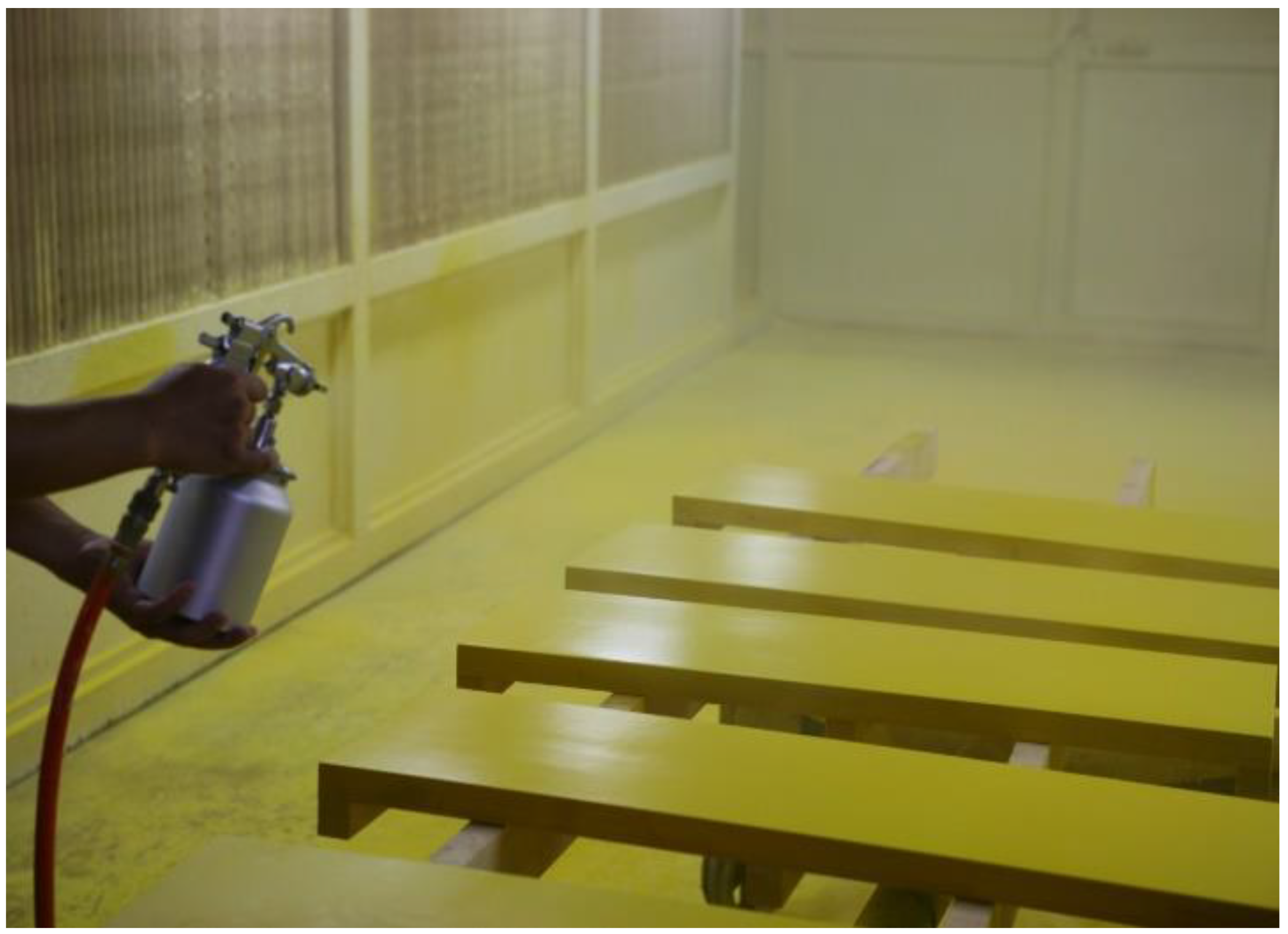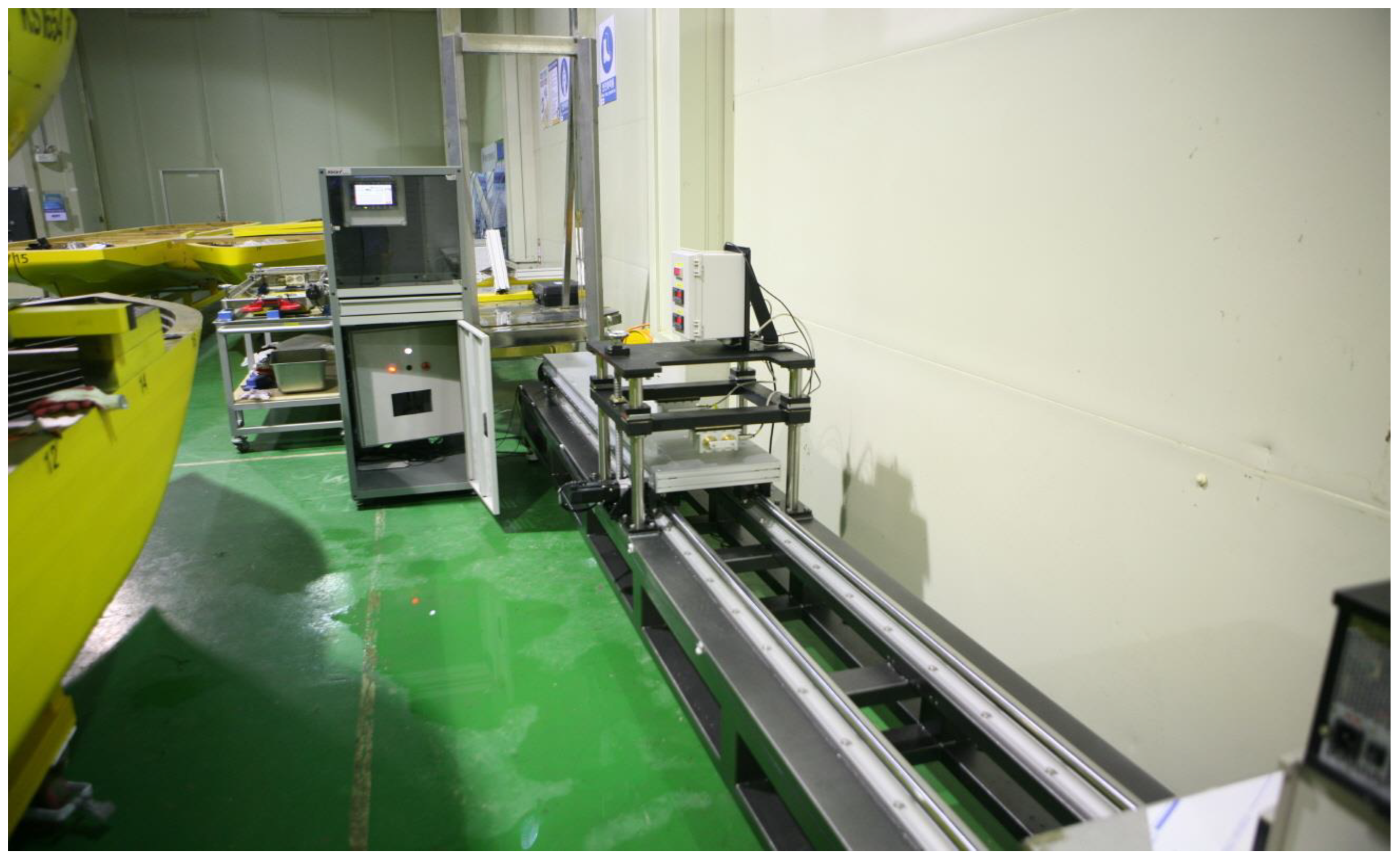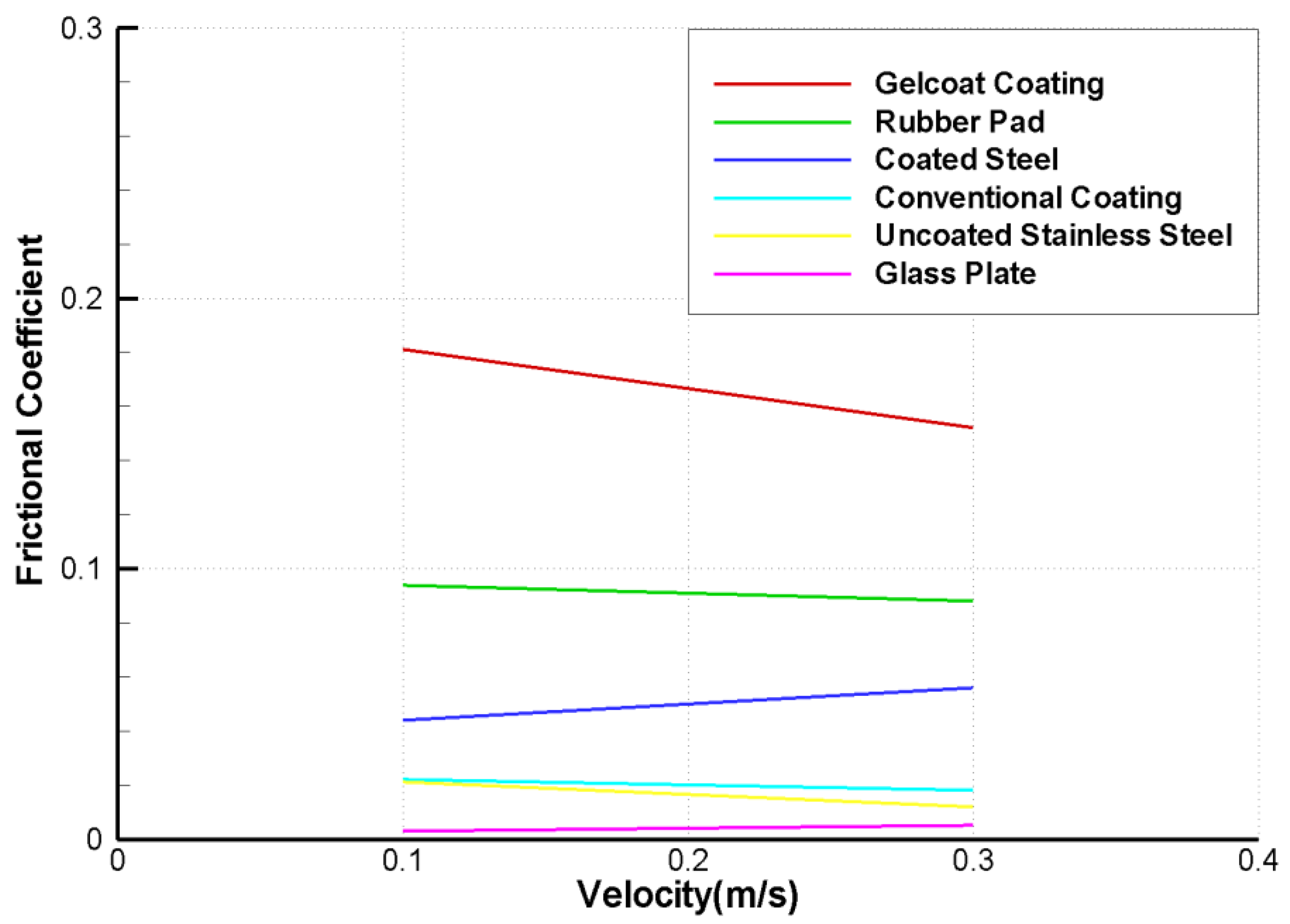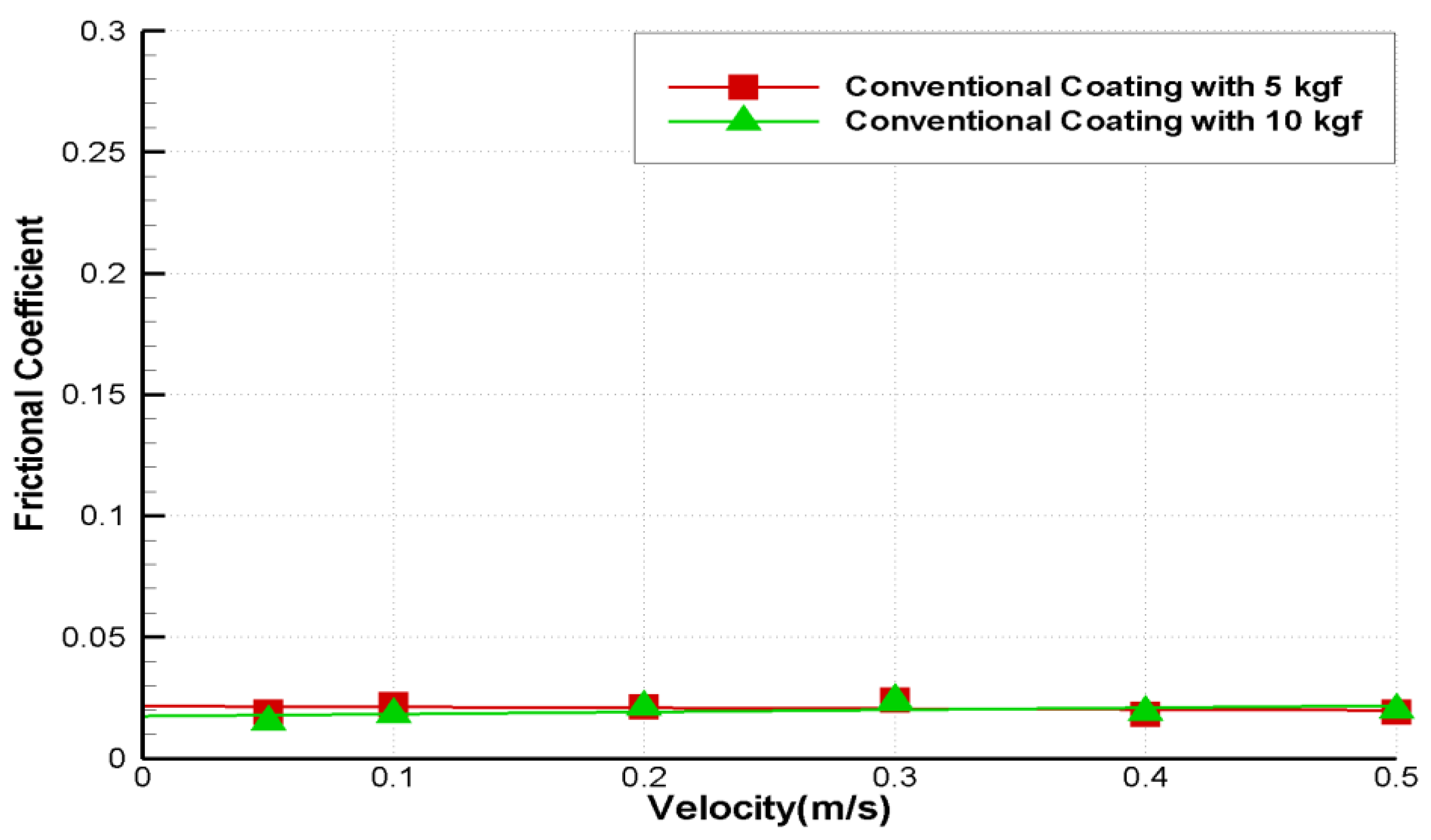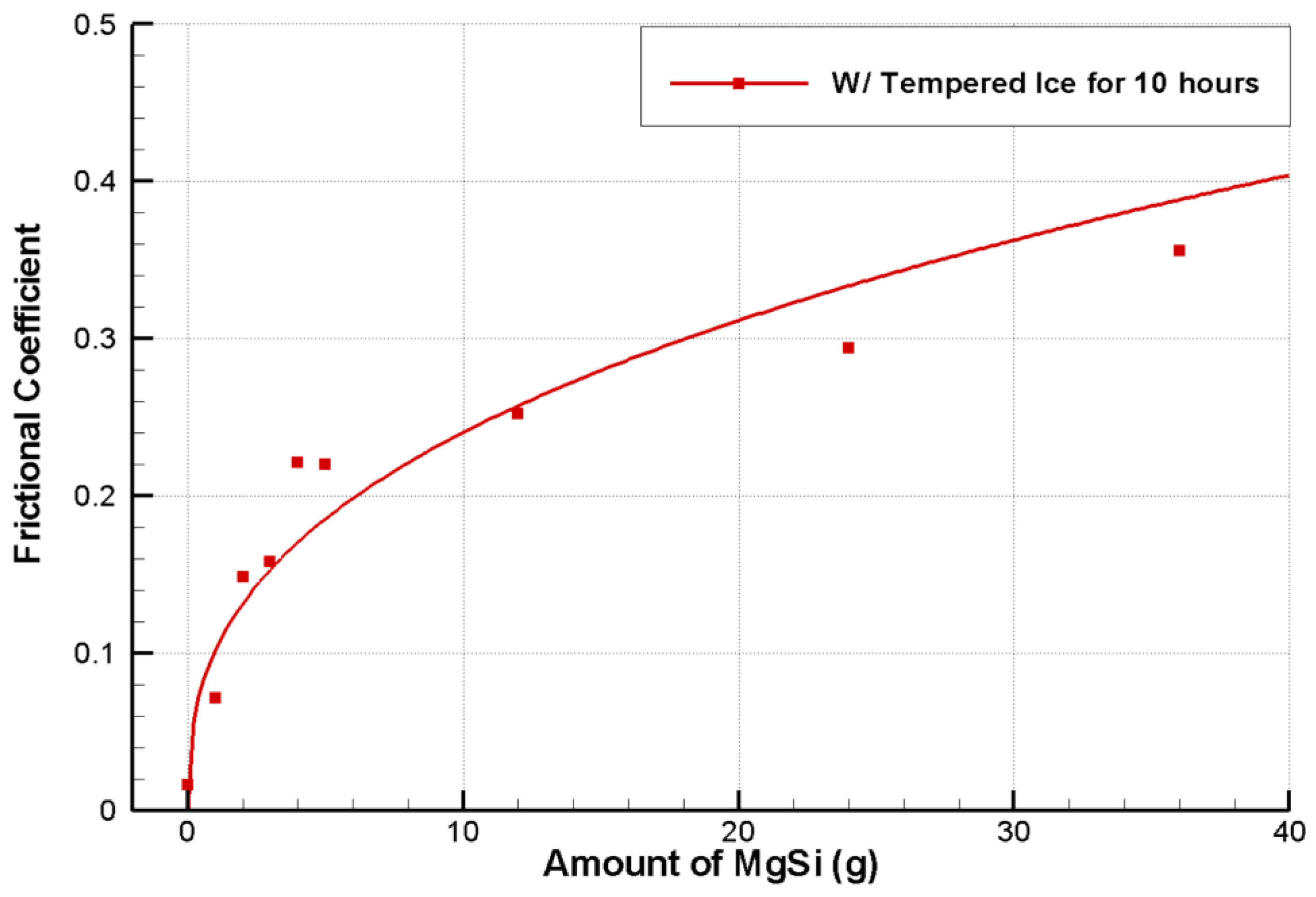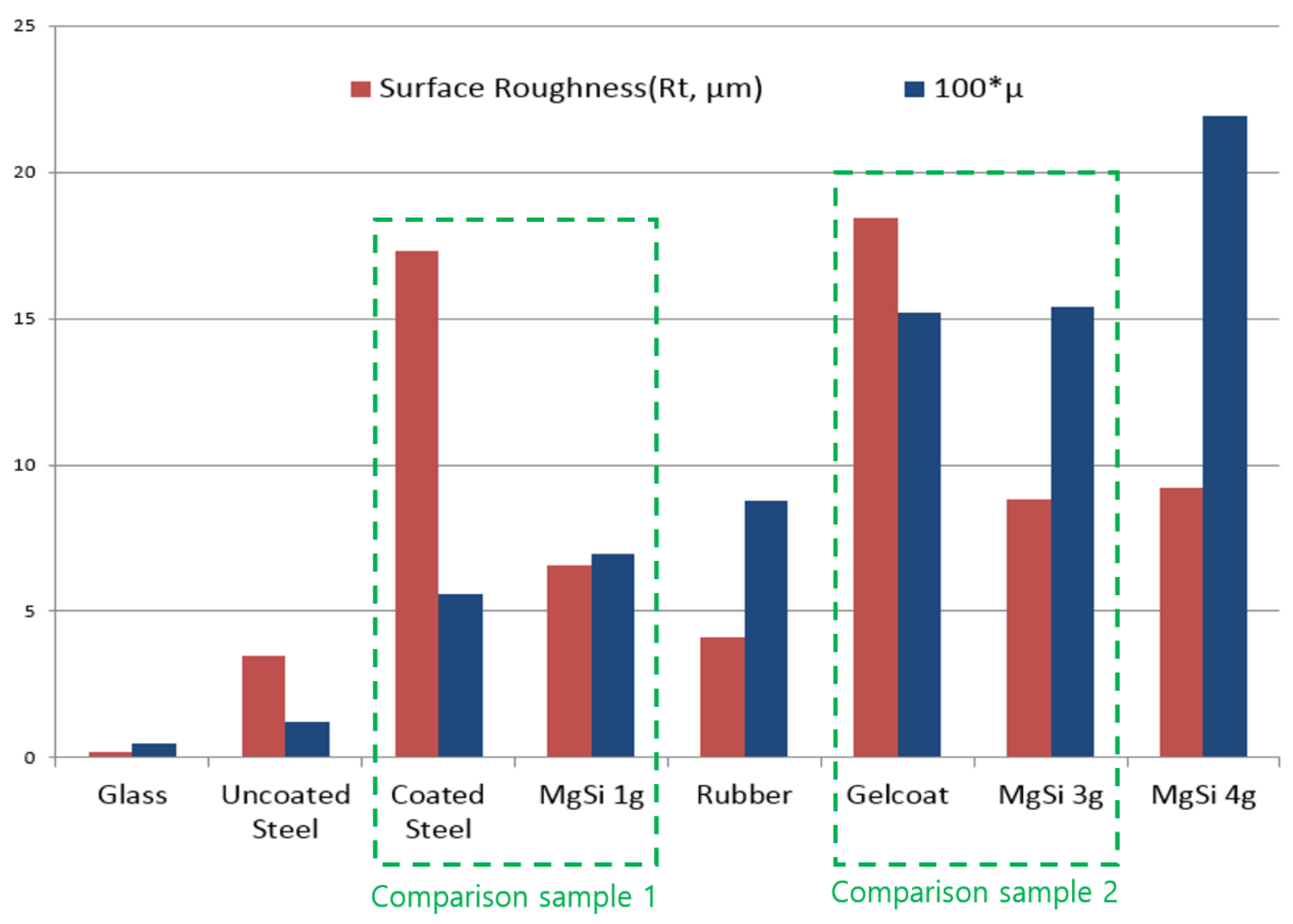1. Introduction
Ice is water, frozen into a solid state; ice on land covers about 10% of the Earth’s land mass [
1], while sea ice covers about 12% of the world’s oceans [
2]. This ice not only disobeys the principles of basic physics of adhesion and friction when the ice contacts other solid materials but also is unusual in that the melting curve has a negative slope with the melting point at atmospheric pressure being at 273.15 K since ice increases in volume when water freezes. In addition, the elastic modulus and strength of ice show very different behaviors that depend on temperature, loading rate, impurity content, and ice formation history, so ice is a very difficult material to carry out the computational fluid dynamics (CFD) and the result of CFD with ice commonly makes many of error.
This strong adhesion of ice to other materials is a unique property of the ice-solid interface and greatly depends on their interface condition, such as the surface finish, the type of material, and the angle of contact between them. In contrast, there have been attempts to develop fast and effective instruments by using a property of low frictional coefficient, such as skates and skis [
3]. Research on the adhesion and friction of ice, however, is still in its early stage.
James Thomson [
4] insisted that a low frictional coefficient is caused by the pressure melting of ice due to the linear dependence of the freezing point depression on pressure. Michael Faraday [
5], on the other hand, hypothesized that a thin film of liquid covered the surface of ice even at temperatures below freezing in 1859. John Joly [
6] calculated that an ice sheet can melt and create a film of water at −3.5 °C when the skater skates because a skater’s blade contacts the ice over so small an area and the pressure of the blade edge is so great. But he could not figure out how to skate at temperatures lower than −3.5 °C. Osborne Reynolds [
7] also explained frictional heating between ice and other materials to understand ice skating instead of pressure melting. Bowden et al. [
8] published a paper associated with ice friction, focusing on the lubrication effect of pressure melting and frictional heat on ice. Evans et al. [
9] developed semi-quantitative models for the frictional melting process, which predict the dependence of sliding speed and temperature.
Much of the literature related to ship-ice friction based on a low frictional coefficient with ice has been published. Enkvist [
10] measured the frictional coefficient of ice with metal plates, and presented that the frictional coefficient of plates on ice decreases as the normal load increases. Ryvlin [
11] carried out with freshwater ice, and presented that the coefficient of friction decreases at a load of 10 kPa or less. Vuorio [
12] also showed that the coefficient of ice over a hull surface increases as the velocity increases. On the other hand, the coefficient of hull surface over ice remains constant when the velocity increases. Moreover, Vuorio stated that the surface roughness would affect the coefficient of friction greatly; however, it can not be applied in all cases. For instance, a plate coated by Inerta160 paint for ice-class vessels had a lower coefficient than an aluminum plate, even though the roughness of the plated coated by Inerta160 paint (1.6 μm,
Ra) was much higher than that of the aluminum plate (0.3 μm,
Ra). However, he never showed how the low frictional phenomena might be possible on a rough surface.
In 1991, Bell and Newbury [
13] developed a coating method for ship models of ice tank using magnesium silicate (MgSi) powders to control the hull roughness, and Colbeck [
14] also carried out many series of friction tests between snow and other materials. In recent, Somorjai [
15] discovered that ice has a quasi-fluid layer that covers the surface of the ice, even when the ice is −129 °C, and Watanabe [
16] conducted research on the influence of environmental conditions on road friction characteristics. Consequently, the layer makes the friction force on ice slippery, and he finally evaluated Faraday’s hypothesis.
In this paper, various friction tests using freshwater ice and ethylene glycol/aliphatic detergent (EG/AD) model ices in the Korea Research Institute of Ships and Ocean Engineering (KRISO) ice tank [
17] were conducted. The purpose of this study is to develop a test method to understand the friction behavior of ice on various plates and to find the friction mechanism of ice through the measured friction force. As a result of tests, the frictional coefficient of ice depends on the roughness of plates, lubrication condition, and ice types. In addition, the correlation between ice and various rough plates is studied, and we found that the friction with an ice greatly depends on the height characteristics roughness of the material (
Rsk,
Rku) as well as the amplitude roughness of the material (
Ra,
Rt, etc.). This study is intended to contribute to the development of painting materials and methods for ice-breaking vessels because these parameters are affected by surface finishing and painting.
3. Results and Discussion
3.1. Surface Roughness Parameters
The results of the measurement of surface roughness are dictated in
Table 2. We did not measure the roughness of two plates that are painted with 5 g and 36 g of MgSi because of the damage to the plates after the friction test. The height characteristics, spacing, and hybrid parameters were measured for only major plates since the measuring and analyzing time were needed for a long time.
The amplitude parameters from Ra to Rt were measured with a consistency; namely, the glass plate had the smallest Ra and Rt in prepared rough plates. What is noticeable here is that the amplitude parameters increase as the amount of MgSi increases, and the coated plate with a MgSi of 2 g would not be prepared correctly. On the other hand, RSk, which is one of the height characteristic parameters, varied regardless of the amount of MgSi according to the painting situation. A small RSk means the positive range of the roughness profile, which is higher than the mean line and is bigger than the negative range of the roughness profile in the whole roughness profile. In addition, the RSk of other material plates would be determined according to the painting method and condition. Moreover, Rku, which is the other height characteristic parameter, changed from 2.25 to 5.05 related to the painting condition. As the amount of MgSi increases, the Rku generally grows bigger, and a probability density of the roughness profile focuses on the mean line. Hence, the roughness profile is sharp. In the case of the spacing parameter, RSm is independent of the amount of MgSi and depends on the painting condition. The RΔq, which is the hybrid parameter, increases as the amplitude parameter is bigger or the amount of MgSi increases.
3.2. Frictional Coefficient with Different Materials
Some friction forces with various materials were measured, and their frictional coefficients were calculated in order to study a fundamental mechanism of ice friction. The EG/AD model ice was used, and the friction tests were conducted at an ambient temperature of 0 °C with two speeds (0.1 and 0.3 m/s). By using two weights of 5 kg and 10 kg, two repeat tests were carried out, and each frictional coefficient was taken on an average from four values, as shown in
Figure 6. The glass plate, which had the smallest surface roughness in amplitude parameters, shows the lowest frictional coefficient of the tested plates. Generally, the frictional coefficient increases as the surface roughness increases; however, the coefficients of the rubber pad and coated steel have no concern with their amplitude parameters. In addition, the frictional coefficient with ice would not depend on the moving speed, excluding a gelcoat coating plate. The coefficient of the coated steel was near 0.05, and we realized that many ice tanks use 0.05 to 0.10 as a standard ice frictional coefficient [
19].
3.3. Frictional Coefficient with Changing Velocity
Figure 7 shows the frictional coefficient of a conventional coating plate with ice at various moving velocities. Some researchers [
12,
20,
21] reported that the frictional coefficient depends on the moving velocity, while others [
10,
11,
22] presented that there is no effect at a velocity of 0.1–0.5 m/s. In this test, the coefficient was not changed in a speed range of 0.05–0.5 m/s and with normal loads of 5 kg and 10 kg.
3.4. Frictional Coefficient with Freshwater Ice
Figure 8 shows the frictional coefficient of various materials with freshwater ice and EG/AD model ice against moving speed. The result was measured near the frictional coefficient with EG/AD model ice (
Figure 6), and the trend was also similar. However, the coefficient of the rubber pad, which had high surface roughness, decreased to 0.04 because the roughness of freshwater was so smooth. The freshwater was ground with a stainless steel plate in order to make uniform freshwater ice specimens; meanwhile, the EG/AD model ice was prepared with micro-bubbles for controlling its density, and the roughness of EG/AD model ice was rougher than one of freshwater ice. This caused the coefficient to decrease a little.
3.5. Discussion
Figure 9 shows the measured frictional coefficient for the painted plate while varying the amount of MgSi in the paint to adjust the roughness of the model ship. Based on 5 g of MgSi, it can be seen that the friction coefficient changes with two slopes, and the trend line is plotted using Power-Fit. Although we did not measure the roughness of two plates that are painted with 5 g and 36 g of MgSi, overall, it can be seen that an increase in the amount of MgSi results in an increase in roughness, and, finally, an increase in the coefficient of friction.
Figure 10 shows the relation between the fundamental roughness of the plates, especially the total height of the profile (
Rt), and their frictional coefficients. All the tests were carried out with a weight of 5 kg at 0.2–0.36 m/s. In addition, we measured about 100 points for each test plate and obtained the average value, as shown in
Table 2.
First of all, most of the frictional coefficient depends on the surface roughness of plates, especially the amplitude parameter; namely, the coefficient increases as the total height of the profile increases. These results show a tendency similar to the frictional behavior of other common materials and seem to be equally applicable to the frictional behavior of ice; however, it is not absolute. The total roughness of coated steel and MgSi 1 g is quite different, even though the frictional coefficients are similar. A similar phenomenon occurs with Gelcoat and MgSi 3 g. Also, Vuorio’s results, discussed above, could be from the same phenomenon here as well. Vuorio never showed how the low frictional phenomena might be possible on a rough surface. No one has proposed and explained the principle behind this strange frictional behavior of ice.
To explain phenomena that do not satisfy these basic physical laws in the frictional behavior of ice, we analyzed the supplementary roughness of the test plates (height characteristics, spacing, and hybrid parameters) in
Table 2.
Rsk is the skewness of the roughness surface elevation probability density function, and R
ku is the kurtosis of the surface elevation distribution. If the
Rsk > 0, the peak of the roughness profile is higher than the average line. If the
Rku > 3, the roughness profile is generally sharp, and if the
Rku < 3, the roughness profile is blunt.
RSm is the mean spacing between peaks, and
RΔq is the RMS average of the absolute value of the slope of the roughness profile over the evaluation length.
In
Table 2, the height characteristics parameters of coated steel and coated plate with Gelcoat were smaller than those of MgSi 1 g and MgSi 3 g, respectively, even though the amplitude parameters of coated steel and gelcoat plate were higher. That is, the
Rsk of coated steel, MgSi 1 g, and coated plate with Gelcoat had a negative value, so we can estimate that their roughness profile is round. In addition, the
Rku of coated steel is also small, and this means that the top of the roughness profile is not sharp but blunt in the whole roughness surface elevation probability density function. We also checked the similar phenomenon between coated plated with Gelcoat and MgSi 3 g (comparison sample 2 in
Figure 10). In addition, there is no consistency in the roughness data (
Rt) according to the change in the amount of MgSi (
Table 2), but the friction coefficient increase linearly (
Figure 9), so it is judged that not only the amplitude parameter but also the height characteristic parameter are related and affect the friction behavior of ice. Therefore, we found that the friction of ice depends on both the amplitude and height characteristics of the material.
4. Conclusions
This study was first conducted to understand basic frictional characteristics and phenomena with ice. We tested and evaluated the frictional coefficients of various materials, as well as the measuring methods with freshwater ice and model ice. Thus, we found a fundamental mechanism and tribological behavior of ice on various materials.
Figure 10 shows that Amonton’s law of friction, that the frictional coefficient increases with increasing roughness, does not hold for ice. Through this research, we also confirmed that the frictional coefficient of ice depends on the surface roughness of the test plate, but that this is not absolute. We found the main influencing factors affecting ice friction phenomena through ice friction tests of various materials and precise roughness measurement of test plates. Finally, we conclude that the coefficients of ice is contingent on the amplitude parameters, but also the skewness of the roughness surface elevation probability density function and the kurtosis of the surface elevation.
This study can be valuably utilized in the design phase of ice-class vessels, the coating phase of the hull, and the sea trial tests. The coating method, as well as the basic characteristics of the paint, can change the amplitude and height characteristics parameters of the hull surface; therefore, a study of the tribological behavior of ice must be a core technology for reducing the frictional resistance of an ice-class vessel. Finally, we expect the findings of this study to improve the efficiency and economics of operation for ice-class vessels.
